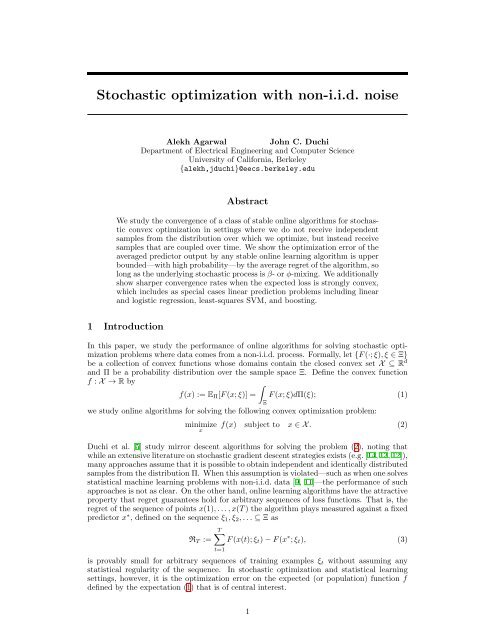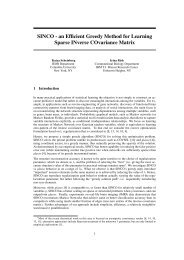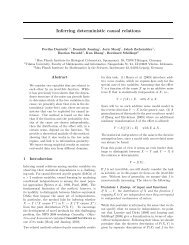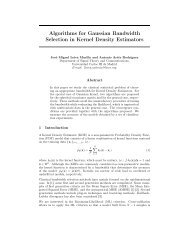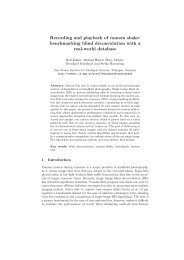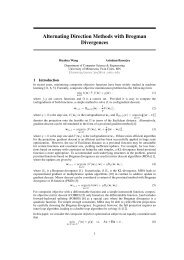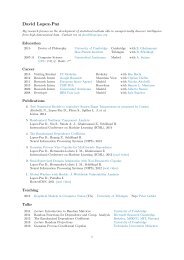Stochastic optimization with non-iid noise - Optimization for Machine ...
Stochastic optimization with non-iid noise - Optimization for Machine ...
Stochastic optimization with non-iid noise - Optimization for Machine ...
You also want an ePaper? Increase the reach of your titles
YUMPU automatically turns print PDFs into web optimized ePapers that Google loves.
<strong>Stochastic</strong> <strong>optimization</strong> <strong>with</strong> <strong>non</strong>-i.i.d. <strong>noise</strong><br />
Alekh Agarwal<br />
John C. Duchi<br />
Department of Electrical Engineering and Computer Science<br />
University of Cali<strong>for</strong>nia, Berkeley<br />
{alekh,jduchi}@eecs.berkeley.edu<br />
Abstract<br />
We study the convergence of a class of stable online algorithms <strong>for</strong> stochastic<br />
convex <strong>optimization</strong> in settings where we do not receive independent<br />
samples from the distribution over which we optimize, but instead receive<br />
samples that are coupled over time. We show the <strong>optimization</strong> error of the<br />
averaged predictor output by any stable online learning algorithm is upper<br />
bounded—<strong>with</strong> high probability—by the average regret of the algorithm, so<br />
long as the underlying stochastic process is β- or φ-mixing. We additionally<br />
show sharper convergence rates when the expected loss is strongly convex,<br />
which includes as special cases linear prediction problems including linear<br />
and logistic regression, least-squares SVM, and boosting.<br />
1 Introduction<br />
In this paper, we study the per<strong>for</strong>mance of online algorithms <strong>for</strong> solving stochastic <strong>optimization</strong><br />
problems where data comes from a <strong>non</strong>-i.i.d. process. Formally, let {F (·; ξ), ξ ∈ Ξ}<br />
be a collection of convex functions whose domains contain the closed convex set X ⊆ R d<br />
and Π be a probability distribution over the sample space Ξ. Define the convex function<br />
f : X → R by<br />
∫<br />
f(x) := E Π [F (x; ξ)] = F (x; ξ)dΠ(ξ); (1)<br />
we study online algorithms <strong>for</strong> solving the following convex <strong>optimization</strong> problem:<br />
minimize<br />
x<br />
Ξ<br />
f(x) subject to x ∈ X . (2)<br />
Duchi et al. [5] study mirror descent algorithms <strong>for</strong> solving the problem (2), noting that<br />
while an extensive literature on stochastic gradient descent strategies exists (e.g. [14, 13, 12]),<br />
many approaches assume that it is possible to obtain independent and identically distributed<br />
samples from the distribution Π. When this assumption is violated—such as when one solves<br />
statistical machine learning problems <strong>with</strong> <strong>non</strong>-i.i.d. data [9, 11]—the per<strong>for</strong>mance of such<br />
approaches is not as clear. On the other hand, online learning algorithms have the attractive<br />
property that regret guarantees hold <strong>for</strong> arbitrary sequences of loss functions. That is, the<br />
regret of the sequence of points x(1), . . . , x(T ) the algorithm plays measured against a fixed<br />
predictor x ∗ , defined on the sequence ξ 1 , ξ 2 , . . . ⊆ Ξ as<br />
R T :=<br />
T∑<br />
F (x(t); ξ t ) − F (x ∗ ; ξ t ), (3)<br />
t=1<br />
is provably small <strong>for</strong> arbitrary sequences of training examples ξ t <strong>with</strong>out assuming any<br />
statistical regularity of the sequence. In stochastic <strong>optimization</strong> and statistical learning<br />
settings, however, it is the <strong>optimization</strong> error on the expected (or population) function f<br />
defined by the expectation (1) that is of central interest.<br />
1
When data is drawn i.i.d. from an underlying probability distribution, Cesa-Bianchi et al. [3]<br />
have shown that online learning algorithms can indeed output predictors that approximately<br />
minimize the expected function f. Specifically, <strong>for</strong> convex loss functions, the average of the<br />
T predictors played by the online algorithm has <strong>optimization</strong> error (nearly) bounded by<br />
the average regret R T<br />
T<br />
<strong>with</strong> high probability. We ask the same question when the data<br />
ξ t is drawn according to a dependent process. To that end, we show that online learning<br />
algorithms enjoy high-probability convergence guarantees when the samples ξ 1 , ξ 2 , . . . <strong>for</strong>m<br />
a β- or φ-mixing sequence. In particular, we prove that stable online learning algorithms—<br />
those that do not change the predictor x(t) too aggressively between iterations—converge<br />
to the minimum of the population objective f. In favorable regimes of geometric mixing, we<br />
demonstrate convergence rates of O(log T/ √ T ) after T iterations when the loss functions F<br />
are convex and Lipschitz. We also demonstrate faster O(log T/T ) convergence when the loss<br />
function is strongly convex in the hypothesis x, which is often the case <strong>for</strong> regularized problems<br />
such as SVMs, regularized logistic regression, , kernel ridge regression and maximum<br />
entropy estimation. In addition, we consider linear prediction settings, and show O(log T/T )<br />
convergence when a strongly convex loss is applied to a linear predictor 〈x, ·〉, which gives<br />
fast rates <strong>for</strong> problems such as least squares SVMs, linear regression, logistic regression, and<br />
boosting over bounded sets, when samples are not independent and identically distributed.<br />
We build off of a recent paper by Duchi et al. [5], who show high probability bounds on the<br />
convergence of the mirror descent algorithm even in dependent <strong>noise</strong> settings. In particular,<br />
while their results only apply to mirror descent algorithm, here we show a broad family of<br />
algorithms to optimize <strong>with</strong> <strong>non</strong>-i.i.d. data. We also extend their martingale techniques by<br />
exploiting recent ideas of Kakade and Tewari [8], and use a weakened versions of β and φ-<br />
mixing <strong>for</strong> our high probability results. Our proofs use only relatively elementary martingale<br />
convergence arguments, and we do not require that the input data is stationary but only that<br />
it is suitably convergent. More details and proofs can be found in the full-length version [1].<br />
2 Setup, Assumptions and Notation<br />
The online algorithm receives data ξ 1 , . . . , ξ T from the sample space Ξ, where the data is<br />
generated according to a stochastic process P . The algorithm plays points (hypotheses)<br />
x ∈ X , and at iteration t suffers the loss F (x(t); ξ t ). The total variation distance between<br />
distributions P and Q, <strong>with</strong> densities p and q w.r.t. a measure µ, 1 , defined on a space S is<br />
d TV (P, Q) := sup |P (A) − Q(A)| = 1 ∫<br />
|p(s) − q(s)|dµ(s). (4)<br />
A⊂S<br />
2<br />
Define the σ-field F t = σ(ξ 1 , . . . , ξ t ). Let P[s] t denote the distribution of ξ t conditioned on F s ,<br />
that is, given the initial samples ξ 1 , . . . , ξ s . Our main assumption is that there is a stationary<br />
distribution Π to which the distribution of ξ t converges as t grows. We also assume that<br />
the distributions P[s] t and Π are absolutely continuous <strong>with</strong> respect to a fixed underlying<br />
measure µ throughout. We use the following criterion to measure the convergence of P :<br />
Definition 2.1 (Weak β and φ-mixing). The β and φ-mixing coefficients of the sampling<br />
distribution P are defined, respectively, as<br />
{<br />
β(k) := sup 2E[dTV (P t+k (· | F t ), Π)] } {<br />
and φ(k) := sup 2dTV (P t+k }<br />
(· | B), Π) : B ∈ F t .<br />
t∈N<br />
t∈N<br />
The process is φ-mixing (respectively, β-mixing) if φ(k) → 0 as k → ∞, and we assume<br />
<strong>with</strong>out loss that β and φ are <strong>non</strong>-increasing. The above definition is weaker than the<br />
standard definitions of mixing [11, 17], which require mixing over the entire tail σ-field of<br />
the process; we require mixing over only the single-slice marginal of ξ t+k . We also note that<br />
β-mixing is weaker than φ-mixing since β ≤ φ. Two regimes of mixing are of special interest.<br />
A process is called geometrically β-mixing if β(k) ≤ β 0 exp(−β 1 k θ ) <strong>for</strong> some β i , θ > 0, and<br />
similarly <strong>for</strong> φ. <strong>Stochastic</strong> processes satisfying geometric mixing include finite-state ergodic<br />
Markov chains; we refer the reader to the reference [10] <strong>for</strong> more examples. A process is<br />
1 This assumption is <strong>with</strong>out loss, since P and Q are absolutely continuous <strong>with</strong> respect to P +Q.<br />
S<br />
2
algebraically β-mixing if β(k) ≤ β 0 k −θ <strong>for</strong> some β 0 , θ > 0 (φ(k) ≤ φ 0 k −θ ). Algebraic mixing<br />
holds <strong>for</strong> certain Metropolis-Hastings samplers when the proposal distribution does not have<br />
a lower bounded density [7], some queuing systems, and other unbounded processes.<br />
We make the following standard boundedness assumptions on F and the domain X :<br />
Assumption A (Boundedness). For µ-a.e. ξ, the functions F (·; ξ) are convex and G-<br />
Lipschitz <strong>with</strong> respect to a norm ‖·‖ over X , and X is compact <strong>with</strong> finite radius:<br />
|F (x; ξ) − F (y; ξ)| ≤ G ‖x − y‖ and ‖x − y‖ ≤ R (5)<br />
<strong>for</strong> all x, y ∈ X . Further, F (x; ξ) ∈ [0, GR].<br />
Assumption A implies that the function f defined by the expectation (1) is G-Lipschitz. We<br />
give somewhat stronger results in the presence of the following additional assumption.<br />
Assumption B (Strong Convexity). The expected function f is σ-strongly convex <strong>with</strong><br />
respect to the norm ‖·‖, that is, <strong>for</strong> all g ∈ ∂f(x),<br />
f(y) ≥ f(x) + 〈g, y − x〉 + σ 2 ‖x − y‖2 <strong>for</strong> x, y ∈ X . (6)<br />
To prove generalization error bounds <strong>for</strong> online learning algorithms, we require them to be<br />
appropriately stable, as described in the next assumption.<br />
Assumption C. There is a <strong>non</strong>-increasing sequence κ(t) such that if x(t) and x(t + 1) are<br />
successive iterates of the online algorithm, then ‖x(t) − x(t + 1)‖ ≤ κ(t).<br />
Here ‖·‖ is the same norm as that used in Assumption A. This assumption is different from<br />
the stability condition of Mohri and Rostamizadeh [11], and neither implies the other. It is<br />
common (or at least often straight<strong>for</strong>ward) to bound κ(t) as a part of the regret analysis of<br />
online algorithms (e.g. [16, Lemma 10]), which motivates our assumption here.<br />
3 Main Results<br />
Our goal is to use the sequence x(1), . . . , x(T ) to construct an estimator ̂x T that has a small<br />
<strong>optimization</strong> error f(̂x T ) − f(x ∗ ). In the setting where the samples ξ t are independent and<br />
identically distributed [3, 8], the average ̂x T of the T predictors x(1), x(2), . . . , x(T ) the<br />
online algorithm plays satisfies this condition. We state all our convergence results <strong>for</strong> the<br />
same averaged predictor ̂x T = [x(1) + · · · + x(T )]/T , and provide proofs of all our results in<br />
the full length version of this paper [1].<br />
3.1 Convergence rate <strong>for</strong> convex functions<br />
We begin <strong>with</strong> a bound on the expected generalization error of ̂x T <strong>for</strong> convex Lipschitz<br />
losses; since we measure expectation, β-mixing is a sufficient condition <strong>for</strong> the result.<br />
Theorem 1. Under Assumptions A and C, <strong>for</strong> any τ ∈ N the predictor ̂x T satisfies<br />
E[f(̂x T )] − f(x ∗ ) ≤ 1 T E[R T ] + β(τ)GR + τG T<br />
(<br />
R +<br />
T∑<br />
t=1<br />
)<br />
κ(t) .<br />
The above result holds only in expectation and provides no control over deviations of the <strong>optimization</strong><br />
error. We can apply new martingale concentration techniques to achieve stronger<br />
high-probability bounds as in the following theorem.<br />
Theorem 2. Under Assumptions A and C,<br />
(a) <strong>with</strong> probability at least 1 − δ, <strong>for</strong> any τ ∈ N the predictor ̂x T satisfies<br />
f(̂x T ) − f(x ∗ ) ≤ 1 T R T + τG T<br />
√ T∑<br />
2τ<br />
κ(t) + 2GR<br />
T log τ δ<br />
t=1<br />
+ φ(τ)GR +<br />
τGR<br />
T .<br />
3
(b) <strong>with</strong> probability at least 1 − 2δ, <strong>for</strong> any τ ∈ N the predictor ̂x T satisfies<br />
f(̂x T ) − f(x ∗ ) ≤ 1 T R T + τG √ T∑<br />
2τ<br />
κ(t) + 2GR<br />
T<br />
T log 2τ δ + 2β(τ)GR<br />
δ<br />
t=1<br />
+ τGR<br />
T .<br />
To better illustrate our results, we now specialize them under concrete mixing assumptions.<br />
We begin <strong>with</strong> a corollary giving error bounds <strong>for</strong> geometrically φ-mixing processes (as<br />
defined in Section 2).<br />
Corollary 1. In addition to the conditions of Theorem 2(a), assume φ(k) ≤ φ 0 exp(−φ 1 k θ ).<br />
There exists a finite universal constant C such that <strong>with</strong> probability at least 1 − δ<br />
f(̂x T ) − f(x ∗ ) ≤ 1 [ (log T ) 1/θ<br />
T R G<br />
T + C ·<br />
T φ 1<br />
T ∑<br />
t=1<br />
κ(t) + GR<br />
√<br />
(log T ) 1/θ<br />
φ 1 T<br />
log<br />
(log T )1/θ<br />
δ<br />
Under geometric φ-mixing, the probabilistic terms are of the same order as the i.i.d. setting<br />
[3] to <strong>with</strong>in poly-logarithmic factors. Algebraic mixing yields somewhat slower rates<br />
(see the full version [1] of this paper). More generally, under the same condition on the stability,<br />
an argument similar to that <strong>for</strong> Corollary 7 of Duchi et al. [5] implies f(̂x T ) −f(x ∗ ) → 0<br />
<strong>with</strong> probability one when φ(k) → 0 as k → ∞. Theorem 2(b) can also be extended to<br />
similar corollaries but we omit such discussion here due to lack of space.<br />
To obtain a concrete convergence rate from our results, we need to know bounds on the<br />
stability sequence κ(t) (and the regret R T ). Indeed, <strong>for</strong> two common first-order methods,<br />
online mirror-descent (see e.g. Theorem 11.1 of [4] or the paper [12]) and regularized<br />
dual averaging [16], known convergence results combined <strong>with</strong> Theorem 2 give that <strong>with</strong><br />
probability at least 1 − δ,<br />
f(̂x T ) − f(x ∗ ) ≤ 1 [ GRτ<br />
T R T + C · inf √ + GR √<br />
√ τ log τ ]<br />
τ∈N T T δ + φ(τ)GR , (7)<br />
<strong>for</strong> some universal constant C. The bound (7) captures the known convergence rates <strong>for</strong> i.i.d.<br />
sequences [3, 12, 16, 4] by taking τ = 1, since φ(1) = 0. Further specializing<br />
√<br />
to the geometric<br />
mixing rate of Corollary 1, one obtains an error bound of O(1/(φ 1 T )) to poly-logarithmic<br />
factors; this is essentially same as the generalization error in i.i.d. settings.<br />
3.2 Convergence rates <strong>for</strong> strongly convex functions<br />
It is by now well-known that the regret of online learning algorithms scales as O(log T ) <strong>for</strong><br />
strongly convex functions, a result which is originally due to Hazan et al. [6]. Many online<br />
algorithms, including gradient and mirror descent [2, 6, 15] and dual averaging [16, Lemma<br />
10], satisfy the stability bound ‖x(t) − x(t + 1)‖ ≤ G/(σt) when the loss functions are σ-<br />
strongly convex. Under these conditions, Theorem 1 gives an expected generalization bound<br />
of<br />
√<br />
O(inf τ∈N {β(τ) + τ log T/T }), which is faster than the standard rate of O(inf τ∈N {β(τ) +<br />
τ/T }), but the improvement in rates does not directly apply to Theorem 2. In the next<br />
theorem, we derive sharper guarantees when the expected function f is strongly convex by<br />
extending a self-bounding martingale argument due to Kakade and Tewari [8].<br />
Theorem 3. Let Assumptions A–C hold. For any δ < 1/e, T ≥ 3, <strong>with</strong> probability at least<br />
1 − 4δ log n, <strong>for</strong> any τ ∈ N the predictor ̂x T satisfies<br />
f(̂x T ) − f(x ∗ ) ≤ 2 T R T + 2τG<br />
T<br />
T∑<br />
t=1<br />
κ(t) + 32G2 τ<br />
σT<br />
log τ δ + 4τRG<br />
T<br />
]<br />
.<br />
(3 log τ δ + 1 )<br />
+ 2RGφ(τ).<br />
We can establish the following corollary under the previously mentioned stability bound<br />
‖x(t) − x(t + 1)‖ ≤ G/(σt) <strong>for</strong> strongly convex online learning algorithms.<br />
Corollary 2. In addition to the conditions of Theorem 3, assume the stability bound κ(t) ≤<br />
G/σt. There is a universal constant C such that <strong>with</strong> probability at least 1 − 4δ log T ,<br />
f(̂x T ) − f(x ∗ ) ≤ 2 T R T + C · inf<br />
τ∈N<br />
[ τG<br />
2<br />
σT<br />
log T +<br />
τG2<br />
σT log τ δ + G2<br />
σ φ(τ) ]<br />
.<br />
4
The factor of 2 in front of R T is insignificant, since R T = o(T ) <strong>for</strong> any low-regret online<br />
learning algorithm, so we have no loss in rates. For a few concrete examples, we note that<br />
when the losses F (·; ξ) are σ-strongly convex, online gradient and mirror descent [6, 15], as<br />
well as dual averaging [16], all have R T ≤ C · G 2 log T/σT , so Corollary 2 implies the convergence<br />
bound f(̂x T ) − f(x ∗ ) = O((G 2 /σ) inf τ∈N [τ log T/T + φ(τ)]) <strong>with</strong> high probability.<br />
For example, we can now observe that that online algorithms <strong>for</strong> regularized SVMs satisfy<br />
a sharp high-probability generalization guarantee, even <strong>for</strong> <strong>non</strong>-i.i.d. data.<br />
3.3 Fast rates <strong>for</strong> linear prediction<br />
We now turn to the common statistical prediction setting in which samples come in pairs<br />
of the <strong>for</strong>m (ξ, ν) ∈ Ξ × V, where ν is the label or target value of the sample ξ ∈ R d , where<br />
‖ξ‖ 2<br />
≤ r. We measure the per<strong>for</strong>mance of the hypothesis x on the example (ξ, ν) by<br />
F (x; (ξ, ν)) = l(ν, 〈ξ, x〉), l : V × R → R + , (8)<br />
where l is a loss measuring the accuracy of the prediction 〈ξ, x〉. Many learning problems<br />
fall into the framework (8): linear regression, where the loss is l(ν, 〈ξ, x〉) = 1 2 (ν − 〈ξ, x〉)2 ;<br />
logistic regression, where l(ν, 〈ξ, x〉) = log(1 + exp(−ν 〈ξ, x〉)); boosting; and SVMs all have<br />
the <strong>for</strong>m (8). The natural curvature assumption in this setting is the following.<br />
Assumption D (Linear strong convexity). For fixed ν, the loss function l(ν, ·) is a σ-<br />
strongly convex and L-Lipschitz scalar function over [−Rr, Rr]:<br />
l(ν, b) ≥ l(ν, a) + l ′ (ν, a)(b − a) + σ 2 (b − a)2 and |l(ν, b) − l(ν, a)| ≤ L|a − b|<br />
<strong>for</strong> any a, b ∈ R <strong>with</strong> max{|a|, |b|} ≤ Rr.<br />
Logistic and linear regression, least-squares SVMs, and boosting on a bounded domain<br />
satisfy Assumption D. Whenever the covariance Cov(ξ) of ξ is <strong>non</strong>-degenerate under the<br />
stationary distribution Π, Assumption D implies the expected function f is strongly convex,<br />
putting us in the setting of Theorem 3. If we had access to a stable online learning algorithm<br />
<strong>with</strong> small regret (i.e. both R T = O(log T ) and ∑ T<br />
t=1<br />
κ(t) = O(log T )) <strong>for</strong> losses of the<br />
<strong>for</strong>m (8) satisfying Assumption D, we could simply apply Theorem 3 to guarantee good<br />
generalization properties of the predictor ̂x T . We do not know of an existing algorithm<br />
satisfying our desiderata of logarithmic regret and stability. Online gradient descent and dual<br />
averaging algorithms guarantee stability, but do not attain O(log T ) regret since F (·; ξ) is no<br />
longer strongly convex, and while Hazan et al. [6] show that online Newton and follow the<br />
approximate leader (FTAL) algorithms have logarithmic regret, neither algorithm satisfies<br />
even a weakened <strong>for</strong>m of the stability assumption C. Thus we define a new update that<br />
combines FTAL <strong>with</strong> the Vovk-Azoury-Warmuth <strong>for</strong>ecaster [4, Chapter 11.8]:<br />
x(t) = argmin<br />
x∈X<br />
{ ∑t−1<br />
〈∇F (x(i); (ξ i , ν i )), x〉 + σ 2<br />
i=1<br />
}<br />
∑t−1<br />
〈x(i) − x, ξ i 〉 2 + σ 2 x⊤ (ξ t ξt<br />
⊤ + ɛI)x .<br />
We have the following result <strong>for</strong> the algorithm (9) under Assumption D.<br />
Theorem 4. Assume ‖x‖ 2<br />
≤ R <strong>for</strong> x ∈ X ⊆ R d , and let x(t) be generated according to the<br />
update (9) <strong>with</strong> ɛ = 1. Then <strong>with</strong> probability at least 1 − 4δ log n, <strong>for</strong> any τ ∈ N,<br />
f(̂x T ) − f(x ∗ ) ≤ L2 d<br />
σT (9 + 14τ) log ( r 2 T + 1 ) + σ T ‖x∗ ‖ 2 2 + 32L 2 r 2 τ<br />
σT · λ min (Cov(ξ)) log τ δ<br />
+<br />
(3 8τL2 log τ )<br />
σT δ + 1 + 4L2<br />
σ φ(τ).<br />
The proof of the theorem requires showing a regret guarantee <strong>for</strong> the update (9), which<br />
adapts related arguments [6, 16] in the literature, as well as developing and controlling a<br />
new weakened <strong>for</strong>m of the stability assumption C. We can further specialize Theorem 4<br />
using different mixing mixing assumptions on the process. As in Corollary 1, we have<br />
i=1<br />
(9)<br />
5
Corollary 3. In addition to the conditions of Theorem 4, assume P is geometrically φ-<br />
mixing. There exists a universal constant C such that <strong>with</strong> probability at least 1 − δ log T ,<br />
[<br />
f(̂x T ) − f(x ∗ L 2 d(log T ) 1+ 1 θ L 2 ( ) ] (log T ) 1 θ log T<br />
) ≤ C ·<br />
+<br />
φ 1 σT φ 1 σT · λ min (Cov(ξ)) log .<br />
δ<br />
4 Conclusions and Discussion<br />
In this paper, we have shown that the martingale concentration arguments used to derive<br />
online to batch conversions <strong>for</strong> independent data [3, 8] can be extended to situations where<br />
the somewhat brittle assumptions of i.i.d. samples do not hold. As is the case <strong>for</strong> earlier<br />
generalization guarantees <strong>for</strong> online learning, our arguments require only elementary martingale<br />
convergence arguments, and we do not need the more powerful tools of empirical<br />
process theory (e.g. [17]). Our results are of particular interest <strong>for</strong> machine learning problems:<br />
just as guarantees <strong>for</strong> stochastic <strong>optimization</strong> imply generalization error bounds in<br />
the i.i.d. case [3], our results establish that any stable online learning algorithm produces<br />
a hypothqesis that can generalize well even on <strong>non</strong>-i.i.d. data samples. Additionally, our<br />
results extend to the settings considered by Duchi et al. [5], yielding a family of algorithms<br />
<strong>for</strong> distributed <strong>optimization</strong> and <strong>optimization</strong> over combinatorial spaces.<br />
References<br />
[1] A. Agarwal and J. C. Duchi. The generalization ability of online algorithms <strong>for</strong> dependent<br />
data. URL http://arxiv.org/abs/1110.2529, 2011.<br />
[2] A. Beck and M. Teboulle. Mirror descent and <strong>non</strong>linear projected subgradient methods <strong>for</strong><br />
convex <strong>optimization</strong>. Operations Research Letters, 31:167–175, 2003.<br />
[3] N. Cesa-Bianchi, A. Conconi, and C. Gentile. On the generalization ability of on-line learning<br />
algorithms. IEEE Transactions on In<strong>for</strong>mation Theory, 50:2050–2057, 2004.<br />
[4] N. Cesa-Bianchi and G. Lugosi. Prediction, learning, and games. Cambridge University Press,<br />
2006.<br />
[5] J. C. Duchi, A. Agarwal, M. Johansson, and M. I. Jordan. Ergodic subgradient descent. URL<br />
http://arxiv.org/abs/1105.4681, 2011.<br />
[6] E. Hazan, A. Agarwal, and S. Kale. Logarithmic regret algorithms <strong>for</strong> online convex <strong>optimization</strong>.<br />
<strong>Machine</strong> Learning, 69, 2007.<br />
[7] S.F. Jarner and G.O. Roberts. Polynomial convergence rates of markov chains. The Annals<br />
of Applied Probability, 12(1):pp. 224–247, 2002.<br />
[8] S. M. Kakade and A. Tewari. On the generalization ability of online strongly convex programming<br />
algorithms. In Advances in Neural In<strong>for</strong>mation Processing Systems 21, 2009.<br />
[9] R. Meir. Nonparametric time series prediction through adaptive model selection. <strong>Machine</strong><br />
Learning, 39:5–34, 2000.<br />
[10] S. Meyn and R. L. Tweedie. Markov Chains and <strong>Stochastic</strong> Stability. Cambridge University<br />
Press, Second edition, 2009.<br />
[11] M. Mohri and A. Rostamizadeh. Stability bounds <strong>for</strong> stationary φ-mixing and β-mixing processes.<br />
Journal of <strong>Machine</strong> Learning Research, 11:789–814, 2010.<br />
[12] A. Nemirovski, A. Juditsky, G. Lan, and A. Shapiro. Robust stochastic approximation approach<br />
to stochastic programming. SIAM Journal on <strong>Optimization</strong>, 19(4):1574–1609, 2009.<br />
[13] B. T. Polyak and A. B. Juditsky. Acceleration of stochastic approximation by averaging. SIAM<br />
Journal on Control and <strong>Optimization</strong>, 30(4):838–855, 1992.<br />
[14] H. Robbins and S. Monro. A stochastic approximation method. Annals of Mathematical<br />
Statistics, 22:400–407, 1951.<br />
[15] S. Shalev-Shwartz and Y. Singer. Logarithmic regret algorithms <strong>for</strong> strongly convex repeated<br />
games. Technical Report 42, The Hebrew University, 2007.<br />
[16] L. Xiao. Dual averaging methods <strong>for</strong> regularized stochastic learning and online <strong>optimization</strong>.<br />
Journal of <strong>Machine</strong> Learning Research, 11:2543–2596, 2010.<br />
[17] Bin Yu. Rates of convergence <strong>for</strong> empirical processes of stationary mixing sequences. Annals<br />
of Probability, 22(1):94–116, 1994.<br />
6


